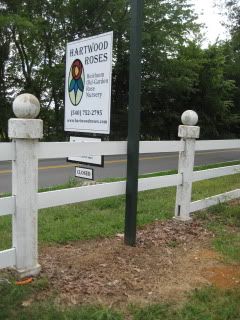I spent last Monday in the garden with the managing editor of the Culpeper Times. She heard me speak at the Culpeper Garden Club’s meeting in July, and she thought the garden here would be a interesting subject for an article.
Here is the article. I think she did a really nice job of capturing the atmosphere I try to create around here. Come visit, and see for yourself.
'A Rose is a Rose is a Rose'
By Anita L. Sherman
Source: Culpeper Times
FRIDAY, AUGUST 21 2009
It's a hot muggy morning and Connie Hilker has a lot of tending to do — there are roses to water, roses to plant, roses to move and rose beds that need weeding. "It's rare that I'm not covered in dirt," said Hilker, who currently has some 800 roses that she lovingly tends.
Visiting Hartwood Roses, like one of her favorites Double Delight, is a two-fold pleasure. A stately brick home, Hartwood Manor, takes center stage on the nine acres. It was built in 1848 in a Gothic-Revival style. Connie, along with her husband Steve, purchased the place in 2002 and has since been renovating it. Surrounding by aging oaks and a majestic pecan tree, Hilker's nursery, which opened in June, is perfectly nestled in history.
Hilker has not only found a home that is the perfect niche, but also a business and passion well suited to this place out of time — raising heirloom old garden roses.
"I can't compete with the large commercial growers," said Hilker. But that's fine with her, as her specialty is the hard-to-find, less-common varieties of roses — perhaps those that bloomed in your mother's or grandmother's garden.
Hilker's collection includes some she has rescued from cemeteries or a bulldozer's path. Pointing to one diminutive bush, Hilker said sadly that the mother plant was gone.
A longtime rose aficionado, Hilker's interest in starting her own nursery gained momentum when a grower in Waynesboro retired. "He was a real super guy, and I wanted to carry on what he had started," said Hilker who has acquired many of her roses from nurseries that have gone out of business.
Hilker's main garden is on what was once a large vegetable garden. Looking out on her row upon row of roses, Hilker said that the first row represents her favorites – China Roses. "The soil here is really, really good," said Hilker, "and it drains very well."
With many ancient European varieties, a stroll through Hilker's gardens is a walk through time, with small tags resonating from 1857 and the Duchesse de Brabant or Daphne from 1912. Then there's the stately General Washington, circa 1860, and delicate Evangeline from 1906.
Specializing in ramblers and climbers, Hilker's roses are all grown on their own roots and propagated on her property. A greenhouse nurses tiny cuttings that are taking root and are gently misted in a recycling water system.
Hilker recently gave a presentation at the Culpeper Garden Club. She has strong ties to Culpeper as her parents live on Lake Pellum, and she has a sister in Stevensburg. A member of the Richmond Rose Society, Hilker is keen on educating people about her heirloom beauties.
If you're not able to come in person, Hilker now offers her selection of vintage roses online.
Open officially each Saturday from 10 - 3 p.m., Hilker spends most of her time looking after her roses. "I'm also open by appointment but, you know, chances are most days I'm here and you can find me in the garden."
(written by Hartwood Roses. Hartwood Rose blog)
December 19, 2025: Shares & Chit Chat
2 hours ago






























